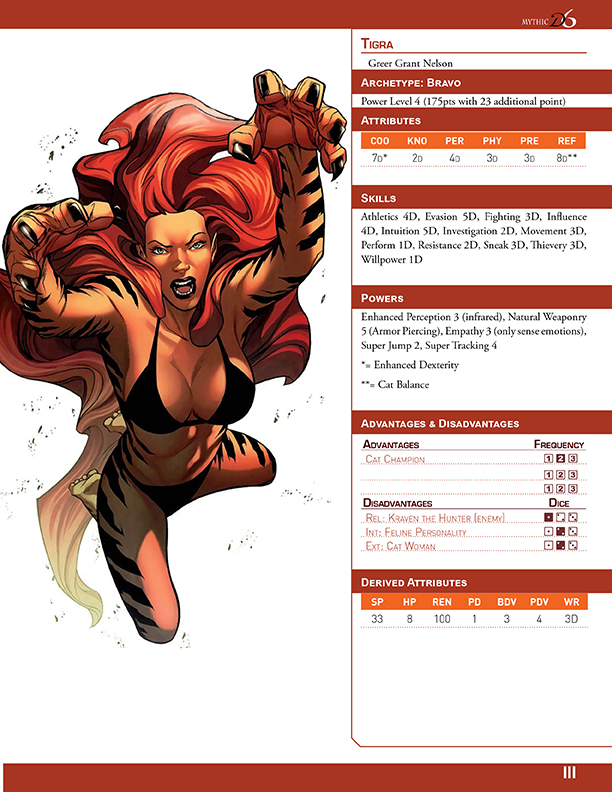A character build can speak volumes about what a game is attempting to do.
MYTHIC D6 is a Roleplaying game geared for Super Heroic Action Adventure styles of play. To illustrate this, we have different fan builds for characters we all know and love.
Below is this week’s build. If anyone out there has their own character builds, I would love to see them.
What would be even more interesting to me, is how a different system expresses the same character. What does the system find important and what does the system simply assume?
Below I give you Tigra!



One response to “Example Character Builds”
That word – do I even know what it means?
"Build."
Let's see, it has to mean options. Either there are different full builds you pick from or you construct your own build from component-type lists or quantities.
I'm not talking about variation such as, for example, number of hit points determined by a roll. I'm talking about the concept of different rolls for hit points among the different character classes.
In terms of options, how is Tigra depicted as above a build rather than, say, simply a presentation of Tigra as an instrument of play, in a particular game-usable form?
One kind of option is that we simply could have chosen different bluntly-obvious things from lists to arrive at a different character entirely, like the Archetype. All else being equal, Tigra as a Rogue is way different from Tigra as anything else.
It's useful to take that idea all the way back 1970s D&D (that's three distinct systems: Gygax & Arneson, Holmes, and Gygax) and think about characters as builds rather than "roll-ups" – because frankly, the rolled numbers meant hardly anything anyway. The options you chose were way more important – and again, some being whole-body as it were, like character class, and others being compartmentalized, like alignment or which spells or weapons you got. The money mechanic was even a bank of "character points" in the sense of Hero Games or GURPS for such things, in many cases.
Or you could have chosen other things inside the smaller "boxes" of the sheet, less all-encompassing items – the equivalent, if you will, of the spells and weapons choices of those long-gone fantasy games (later versions have flattened the consequences, the meaning, of such choices).
Ah ha – I begin to see it, that we are not talking just about options, but options which feed directly into how you play this character. Raw system, even. We speak of a build when those options must be addressed in making a character, at at the most extreme or pointed use of the term, because there's no default or generic or "type" to go on.
For those of you familiar with the evolution of Champions, I'm sure you remember the almost audible moment when character creation became compartmentalized into hero types: the Brick, the Speedster, the Energy Projector, et cetera. I believe these were mentioned and used very casually in one the early supplements (Champions III), but not enshrined as rules until the all-important, utter reboot into the 4th edition, 1989, in the context of the new Hero System. This shift was fervently, eagerly embraced by the game's fanbase – it was as if the original game's utter disavowal of character class had somehow missed the mark for what the audience was yearning for, and now they could think of and make characters in no other way, nor would they choose any differently.
Jerry, that makes me interested in Tigra as depicted, but not as a result (heeerre's Tigra!) but instead as a process. What is known or not known before making any such character? What are the choices, and what is the sequence of making them? Even when we're thinking of a finishing point – more or less to be recognizable as the existing comics hero – the process is highly interpretative. Marv Wolfman's Tigra isn't John Byrne's, and neither, probably, is exactly mine. My "build" would be an expression of how I want to play (see) her, and the question is whether the options as a process permit me to express myself accordingly.
Thoughts?